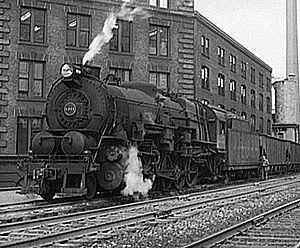PRR I1s
| Pennsylvania Railroad I1s | |
|---|---|
|
PRR I1s prepares to leave the docks at Cleveland, Ohio with a trainload of iron ore in May, 1943. | |
| Type and origin | |
| Power type | steam |
| Builder | Pennsylvania Railroad's Altoona Shops (123); Baldwin Locomotive Works (475) |
| Build date | 1916–1923 |
| Total produced | 598 |
| Specifications | |
| Configuration | 2-10-0 |
| Gauge | 4 ft 8 1⁄2 in (1,435 mm) |
| Locomotive weight | 386,100 pounds (175.1 t) |
| Boiler pressure | 250 psi (1.7 MPa) |
| Feedwater heater | Worthington BL |
| Firegrate area | 69.9 square feet (6.49 m2) |
| Cylinders | 2 |
| Cylinder size | 30½ in bore × 32 in stroke (775 × 813 mm) |
| Performance figures | |
| Tractive effort |
I1s—90,000 lbf (400 kN) I1sa—96,000 lbf (427 kN) |
| Career | |
| Operator(s) | Pennsylvania Railroad |
| Preserved | One - #4483 |

The Pennsylvania Railroad's class I1s steam locomotives were the largest class of 2-10-0 "Decapods" in the United States, with 598 built 1916–1923 (Altoona: 123, Baldwin: 475). They were the dominant freight locomotive on the system until World War II, and they remained in service until the end of PRR steam in 1957. Nicknames for the type included Decs and Hippos, the latter due to the large boiler. Unlike smaller 2-10-0s that preceded them, the I1s design was huge, taking advantage of the PRR's heavy trackage and high allowed axle load, with a wide, free-steaming boiler. Large cylinders enabled the I1s to apply that power to the rails. Their power was undeniable, but they were not popular with the crews, for they were hard riding at all but low speeds. One author described them as the holy terror of the PRR. The large boiler limited the size of the driving wheels, which made it impossible to mount counterweights large enough to balance the piston thrusts. Their factor of adhesion is low, so they were prone to slipping.
Subclass I1sa increased maximum steam cut-off to admit steam for 78% of the piston stroke (rather than the original 50%), boosting low speed tractive effort from 90,000 to 96,000 pounds-force (400 to 430 kN). There was no obvious external difference except for a revised builders' plate (and of course the revised combination lever). I1s locomotives were converted to I1sa during major overhaul; eventually 489 were converted while 109 remained as built.
In 1923 PRR put engine 4358 on the Altoona test plant. The tests below were all stoker fired.
- In two hours at 7.12 miles/hour it consumed 8129 pounds of coal (13398 BTUs per pound) and averaged 71993 pounds of tractive effort at the driver rims, corresponding to 6.4% thermal efficiency.
- In one hour at 14.24 miles/hour it consumed 6809 pounds of coal (12682 BTU/lb) and averaged 63263 pounds tractive effort, or 7.1% efficiency.
- At 22.02 mph (40% cutoff, so not a maximum effort) it consumed 7000 lb/hour of 13039-BTU coal and averaged 43515 lb TE, for 7.1% efficiency.
- At 21.36 mph at 50% cutoff it consumed 5230 lb of 13372-BTU coal in 30 minutes averaging 51409 lb TE, for an efficiency of just under 5.4%.
.jpg)
.jpg)
External links
- PRR #4483 History and Restoration Photos
- Further History of PRR #4483
- Info and Photos on modeling an N Scale PRR I1s
| Wikimedia Commons has media related to Pennsylvania Railroad I1s. |
| ||||||||||||||||||||||||||||||||||||||||||||||||||||||||||||||||||||||||||||||||||||||||||||||||
